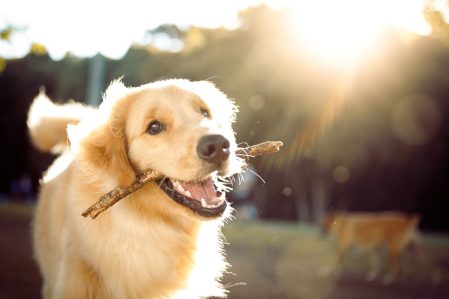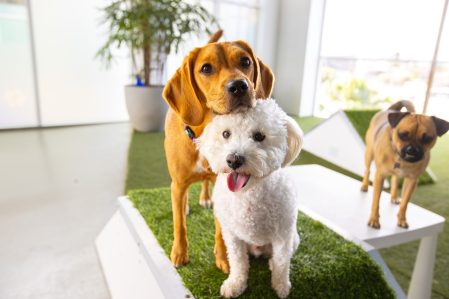Written by Hanrob’s National Head Dog Trainer Hayley
Introducing a new puppy to your home can be an exciting time but most owners will face some challenges along the way.
Knowing when to seek the guidance of a trainer can be tricky, especially if you have owned dogs before. Providing your new family addition (be that puppy or adult dog) the right start will assist them to learn life skills as they go through their developmental stages and find their role within a new family. But even if you want to work on manners with your “old” dog, dog training is vital step in any human dog relationship.

So, when should you engage a trainer?
Trainers enjoy being part of a client/ dog journey, so as early as possible is recommended and can help you set your dog up for success from the start. However, it is never too late to seek guidance and no dog is too old to learn.
What can a dog trainer help you with?
Everything from toilet training, puppy mouthing, nipping, teething, excitability, crate training and developing a routine with structure and boundaries and appropriate socialisation.
Once you have your routine set, your dog will no doubt start pushing the boundaries especially during the testing phase. This may include stealing items, demanding behaviours, inciting play or chase me games or behaviours to seek attention. Knowing how to respond appropriately to these challengers will set your dog up for greater success in the long run.
Then suddenly, you may notice a sudden fear response to objects, people, situations that seem to come from nowhere. Dogs go through several fear periods as they develop, and trainers can guide you on working through these periods effectively.
Once you think all is on track, your dog will hit adolescence! Now you have a teenager on your hands that is sexually developing and thinking they know best! Adolescent dogs often lack impulse control, this is very common for all breeds at this stage.
Trainers can assist you in understanding impulse control, innate desired behaviours and providing solutions and strategies to get your dog through this period with clear communication and resetting those boundaries.
Hanrob trainers appreciate that clients want to own dogs that are manageable around their lifestyle, obedient and well mannered. We also understand that sometimes problem behaviours can cause disruption and affect the human dog relationship.

Here are 5 top tips from our Hanrob trainers to create better relationships, understanding and improve obedience:
1. INCORPORATE THE 3 D’S INTO YOUR TRAINING SESSIONS
Practice the 3 D’s at every opportunity.
DURATION – Build duration in behaviour. This may be to asking for a “stay” and then reward after just a few seconds to slowly increase the duration to a minute.
DISTANCE – Increase the distance. This may be the distance from where you give a cue, the distance you walk or the distance you recall from.
DISTRACTION – Slowly add more distraction into your training sessions to see progression and for proofing.
2. UNDERSTAND YOUR BREED
Get to know your dog and understand what motivates their behaviour – good or bad, its important you provide your dog with the right outlets, be it through reward or activities.
Understanding breed trait behaviours and offering them genetic fulfillment opportunities through play and training will strengthen your bond and create a solid human dog relationship.
3. EVERY OPPORTUNITY IS A TRAINING OPPORTUNITY
Especially true for younger dogs! Training sessions don’t have to be long and structured to have value. See opportunity to train in your daily activities. These could include:
Introducing a wait before getting food, waiting before heading through doors, waiting before going in or out of gates/ crates/ vehicles.
Close handling, such as lifting and checking paws, calm handling skills to assist with regular vet checks.
Learning to calm down or settle, bed threshold, manners around food or people, to manage jumping or begging behaviours
Set boundaries, build independence, provide guidance to enrichment and time alone.
Sniffy walks, obedience walks, parkour walks, teaching tricks, structured play.
Every opportunity that you are with your dog is a training opportunity!
4. FOCUS AND ENGAGEMENT
You can train your dog to look at you or focus attention on you, but this may not mean your dog is not still thinking about a distraction. Your relationship, trust and understanding of the breed you have will play an important role in building engagement.
Being engaged with their owner means the dog understands that there is reward – fun, play, pats, treats, that comes directly from you. We motivate the dog to work with us regardless of distraction. Once your dog is fully engaged you are on the right track to better behaviour and obedience.
How can we work on engagement? We use body animation or movement, we encourage play drive and understand the breed motivation for behaviours, we use high value reward systems, and we practice, practice, practice!
5. CONSISTENCY
Being consistent is the key! Ensure the whole family is involved and understands the words to use or the behaviours to reinforce and the expectation. Be clear and concise with your communication and set your dog up for success!
The dog training journey is a fun and rewarding experience that will strengthen the bond between you and your dog and ensure your dog lives its best life possible. If you would like some guidance from our expert trainers, reach out to Hanrob Pet Hotels Perth.



Wanneroo Business Association and City of Wanneroo are thrilled to bring together our vibrant local business community once again for Wanneroo Business Expo 2024. The eve...